Где покупать оптовые товары для продажи на Amazon
Download Amazon Seller Guide
This guide will help you get started, understand the basics of Amazon selling, and explain in simple words how it all works.
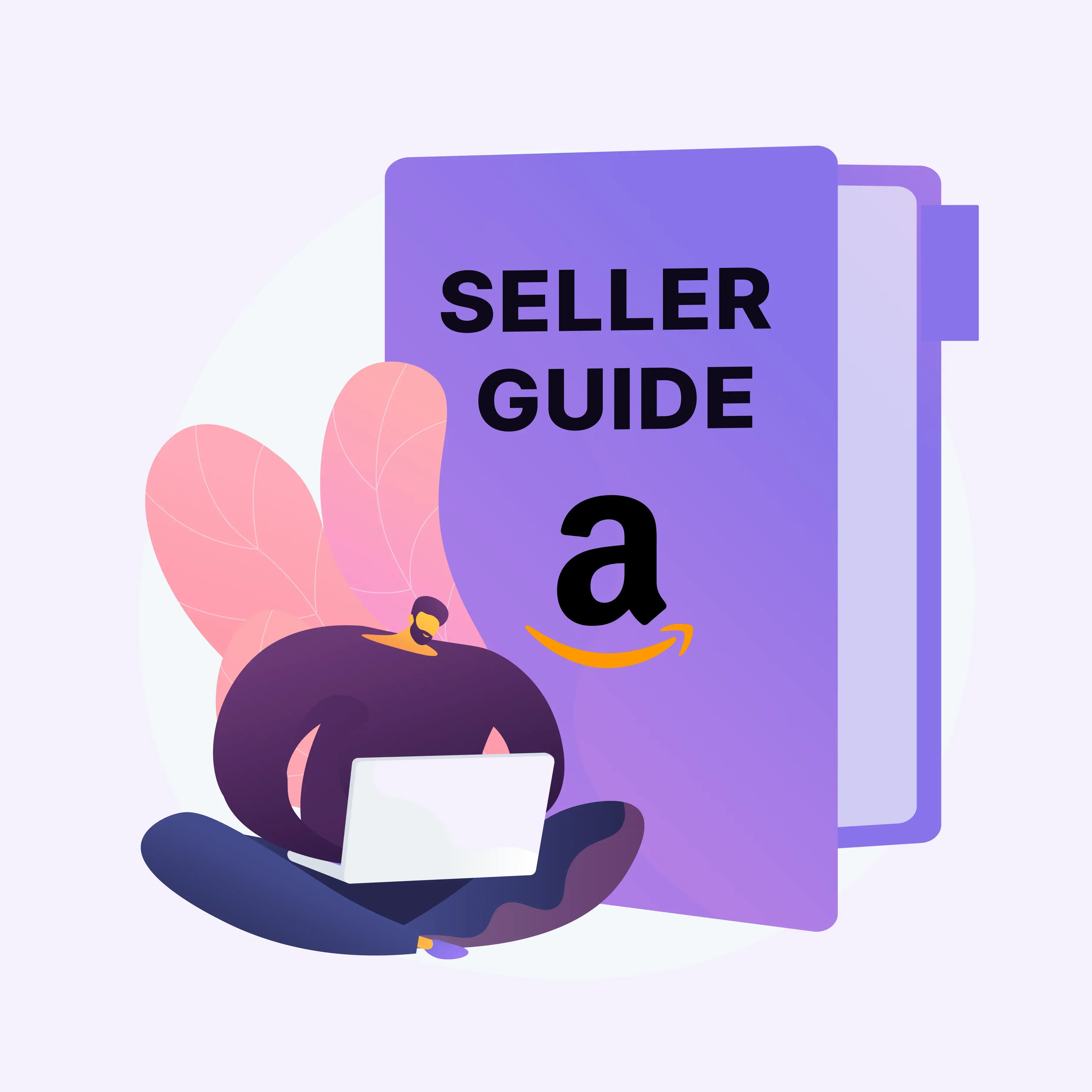
Знание того, где и как покупать оптовые товары для продажи на Amazon, является одним из наиболее важных решений в вашем бизнесе. Независимо от того, являетесь ли вы опытным FBA продавцом или только начинаете, поиск надежных и прибыльных поставщиков является ключом к созданию устойчивой работы.
В условиях постоянно растущей конкуренции устаревшие стратегии поиска товаров просто не сработают. Если вы устали от расплывчатых списков поставщиков и поверхностных советов, вы попали по адресу.
В этом посте мы проведем вас через восемь умных и проверенных методов поиска оптовых товаров для Amazon – от использования отношений с брендами до применения инструментов ИИ и тщательно отобранных баз данных поставщиков. Каждый метод практичен, актуален и разработан, чтобы помочь вам отсеять шум, избежать мошенничества и сосредоточиться на реальных возможностях.
Метод 1. Поиск напрямую у брендов
Многие продавцы Amazon предпочитают продавать оптом на Amazon, работая напрямую с брендами, а не через посредников. Открытие бренда — это более прямой и часто более прибыльный путь – но только если вы знаете, с какими брендами стоит связаться. Не каждый бренд открыт для реселлеров, а некоторые доминируют на Amazon или уже перенасыщены сторонними продавцами.
Чтобы не тратить время, главное — оценивать бренды перед обращением – и Seller Assistant's Brand Analyzer помогает вам в этом.
Примечание. Seller Assistant — это комплексное программное обеспечение для поиска товаров, которое помогает продавцам Amazon быстро находить выгодные предложения. Оно объединяет три расширения: Seller Assistant Browser Extension, и IP-Alert Chrome Extension by Seller Assistant, and VPN by Seller Assistant, инструменты для продавцов Amazon: Price List Analyzer, Brand Analyzer, Seller Spy, Bulk Restrictions Checker, и API integrations, и функции: Storefront Widget, Side Panel View, FBM&FBA Profit Calculator, Quick View, Stock Checker, IP Alert, Variation Viewer, Sales Estimator, Offers, и Restrictions Checker.
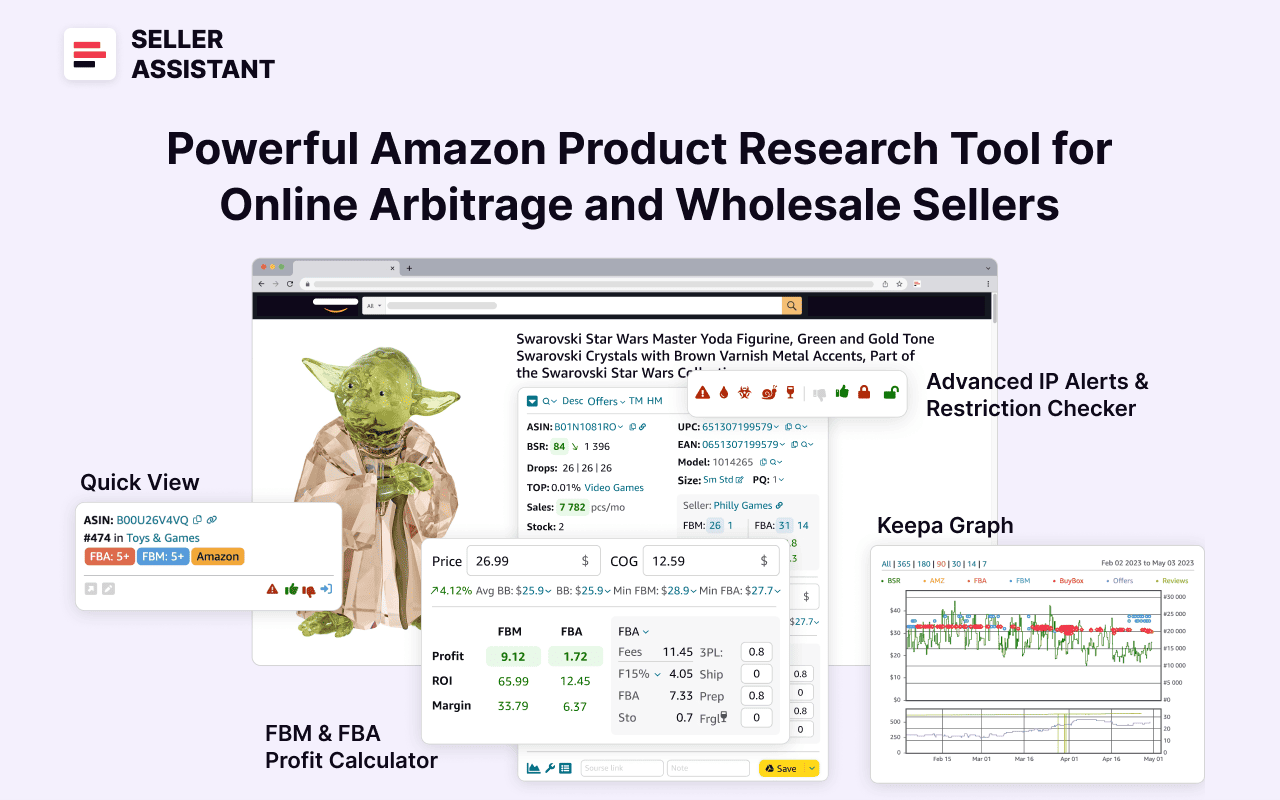
Он предлагает мощный набор из более чем 20 функций, разработанных для оптимизации каждой части процесса поиска товаров – от массового сканирования листов оптовых поставщиков на предмет высокомаржинальных предложений до углубленного исследования продуктов и расширенного анализа брендов и конкурентов. Используя это программное обеспечение для поиска продуктов FBA и FBM, вы можете легко определить продукты, которые имеют потенциал для успешной продажи на Amazon.
Что включает этот метод
Этот подход фокусируется на выявлении прибыльных, подходящих для перепродажи брендов, которые приветствуют сторонних продавцов. С помощью Brand Analyzer вы можете углубиться в данные о производительности, размер каталога и конкуренцию, чтобы убедиться, что каждый бренд стоит того, чтобы им заниматься.

Что помогает Brand Analyzer
Brand Analyzer дает вам полную картину наиболее важных показателей производительности – включая потенциал дохода, насыщенность рынка, наличие запасов, ценовое поведение и тенденции удовлетворенности клиентов. Имея эти данные, вы можете быстро определить бренды, которые дружелюбны к реселлерам и предлагают большой оптовый потенциал.
Инструмент помогает вам определить, является ли бренд хорошим кандидатом для перепродажи и стоит ли с ним связываться напрямую. Он устраняет догадки при исследовании поставщиков, автоматизируя основные этапы оценки бренда – что экономит время и улучшает процесс принятия решений.
Brand Analyzer помогает вам обнаружить

- Он рассчитывает общий ежемесячный объем продаж бренда, агрегируя доход по всем его листингам.
- Он показывает, как часто Amazon контролирует Buy Box, чтобы вы могли оценить риск прямой конкуренции.
- Он показывает среднее количество продавцов FBA на каждый листинг, что помогает вам оценить конкуренцию и сжатие маржи.
- Он перечисляет количество продуктов в каталоге бренда, предоставляя информацию о его масштабе и охвате рынка.
- Он анализирует объем отзывов клиентов и средние рейтинги, давая вам представление о том, как покупатели воспринимают бренд.
- Он сообщает о средней цене Buy Box, что способствует более разумному ценообразованию и планированию прибыли.
- Он включает типичные комиссии FBA за продукт, что позволяет делать более точные прогнозы затрат и маржи.
Как это сделать
Шаг 1. Введите название бренда в Brand Analyzer.
Шаг 2. Оцените следующие данные:
- Количество ASIN
- Ежемесячный доход
- Конкурирующие продавцы
- Доля Amazon в наличии
- Рейтинги продуктов
- Цены Buy Box
Шаг 3. Выберите бренды, которые соответствуют вашим ожиданиям. Свяжитесь с брендами с предложением стать авторизованным реселлером и запросите их оптовые цены и минимальные объемы заказа (MOQ).
Преимущества прямой работы с брендом
- Поиск, основанный на данных
Исключите догадки и сосредоточьтесь на брендах с высоким потенциалом.
- Более выгодные сделки
Прямое обращение к бренду часто приводит к лучшим ценам и меньшему количеству ограничений.
- Развитие партнерства
Прямые отношения легче масштабировать и развивать.
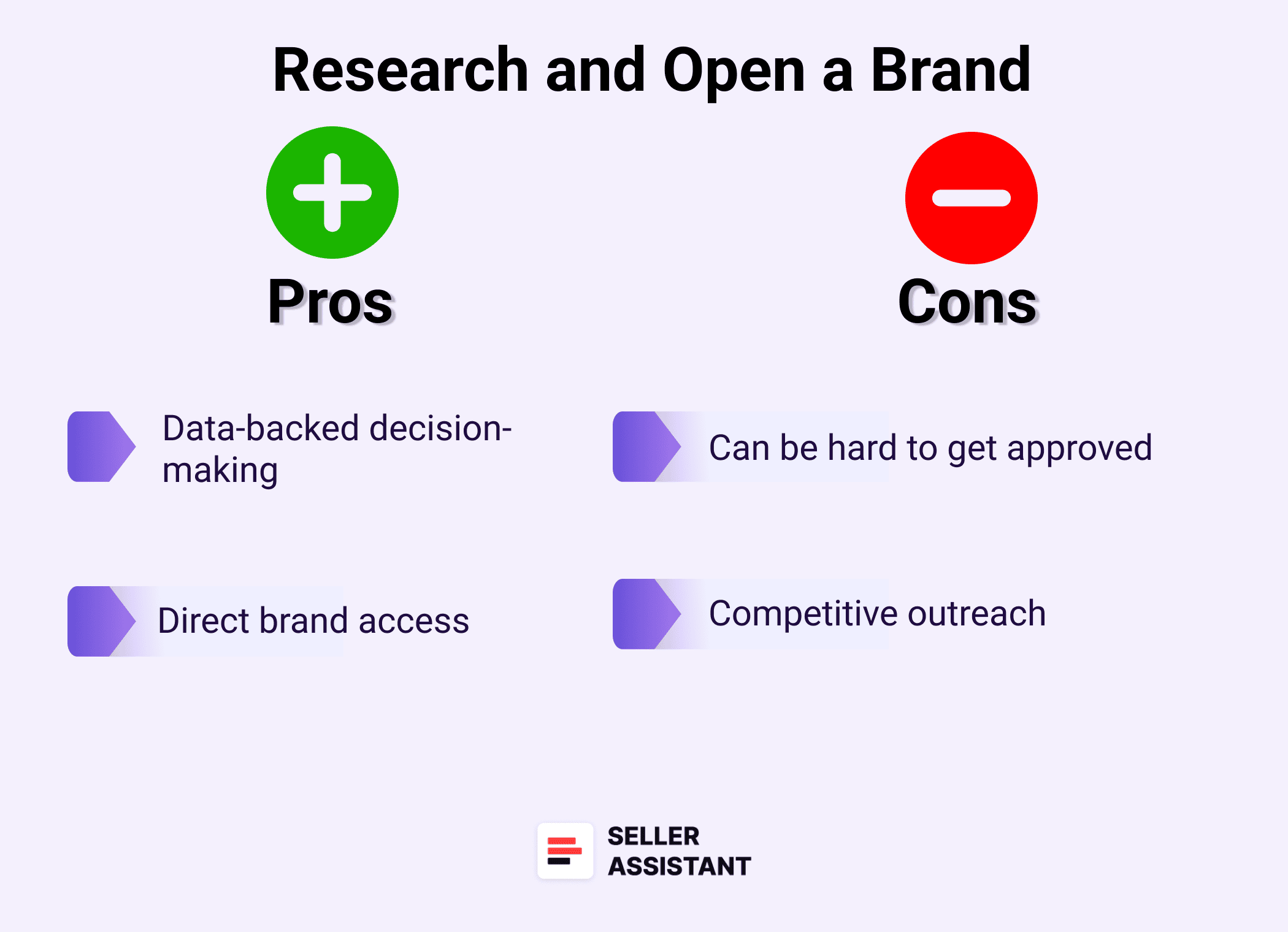
Недостатки, которые следует учитывать
- Сложнее получить одобрение
Многие бренды требуют солидного присутствия в бизнесе и доказательств прошлых продаж.
- Высокая конкуренция в охвате
Другие продавцы, вероятно, обращаются к тем же брендам – ваше сообщение должно выделяться.
Кому это подходит лучше всего
Этот метод идеален для продавцов, которые хотят покупать оптовые товары для продажи на Amazon без посредников и готовы инвестировать в долгосрочные отношения с брендами.
Метод 2. Ищите дистрибьюторов брендов с помощью Sourcing Ai
Многие оптовые продавцы, которые хотят покупать оптовые товары для продажи на Amazon, работают не только напрямую с брендами, но и с их официальными дистрибьюторами. Эти компании часто управляют оптовыми отношениями от имени бренда и более гибки в условиях заказа и процессах утверждения.
Хитрость заключается в том, чтобы найти правильных дистрибьюторов, не полагаясь на устаревшие каталоги или угадывание. Именно здесь на помощь приходят инструменты поиска, основанные на ИИ – такие как Sourcing AI от Seller Assistant. Он может оптимизировать весь процесс поиска оптовых товаров.
Что включает этот метод
Продавцы теперь могут использовать инструменты на основе ИИ для поиска оптовых поставщиков быстрее и точнее, чем когда-либо прежде. Sourcing AI от Seller Assistant создан именно для этой цели. Он разработан, чтобы помочь оптовым продавцам Amazon FBA находить проверенных американских дистрибьюторов для конкретных брендов – особенно тех, которые участвуют в программах больших объемов или авторизованных реселлеров.
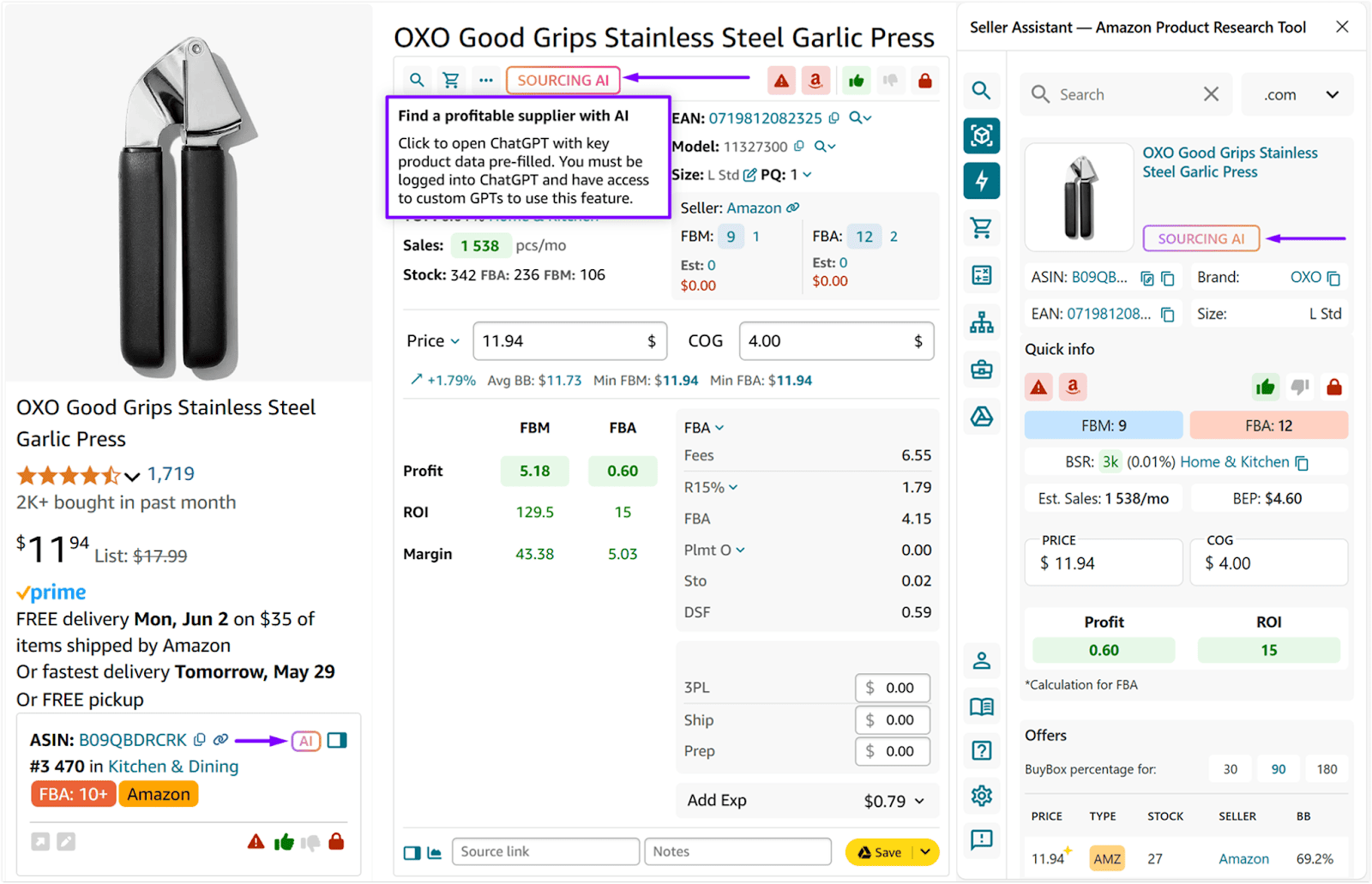
Созданный на основе реальных рабочих процессов Amazon, Sourcing AI имитирует то, как опытные продавцы ищут инвентарь. Он сканирует структурированные данные о продуктах и возвращает таблицу с основными деталями поиска, такими как название поставщика, описание продукта, цены, ссылки, минимальные объемы заказа (MOQ) и примечания – оптимизируя весь процесс поиска оптовых товаров.
Sourcing AI помогает вам обнаружить
Sourcing AI специально разработан, чтобы помочь продавцам Amazon FBA быстро находить реальных, прибыльных американских оптовых поставщиков. Он настроен на точность, скорость и ясность – и отражает логику реального продавца.
- Сопоставление продуктов по идентификатору
Сопоставляет листинги с использованием ASIN, UPC, номеров моделей или номеров деталей – помогая вам находить идентичные или близкие по характеристикам продукты у поставщиков.
- Только проверенные поставщики из США
Исключает результаты из Alibaba, Temu и eBay – сосредоточившись исключительно на проверенных внутренних дистрибьюторах.
- Фильтр максимальной себестоимости (Max COG)
Автоматически удаляет любого поставщика, чья цена превышает вашу максимально допустимую себестоимость товара.
- Подробная таблица поставщиков
Включает название поставщика, информацию о продукте, SKU, MOQ, цену, ссылку и достоверность совпадения (точное или вероятное).
- Работает напрямую из Amazon в инструментах Seller Assistant:
- Страницы продуктов Amazon (Seller Assistant)
- Результаты поиска (Quick View)
- Любой сайт поставщика (Side Panel View)
- Витрины конкурентов (Storefront Widget).
- Предупреждения и подсказки
Выделяет отсутствующие идентификаторы, наборы, мультипаки или неопределенные совпадения – чтобы вы могли перепроверить перед обращением к поставщикам.
Как это сделать
Шаг 1. Начните с посещения страницы продукта Amazon, результатов поиска, витрины конкурента или активации Side Panel View в Seller Assistant. Нажмите кнопку «Sourcing AI» и введите свой запрос – «Найти поставщиков [Название бренда] в США».
Шаг 2. За считанные секунды вы получите структурированную таблицу до 10 поставщиков, включая:
- Название поставщика
- Описание продукта
- Цена
- Прямая ссылка
- Минимальный объем заказа (MOQ)
- Дополнительные примечания по поиску
- Каждая запись помечается как точное или вероятное совпадение, что помогает вам расставлять приоритеты для высокодостоверных источников.
Преимущества использования Sourcing AI
- Быстрый поиск с помощью ИИ
То, что раньше занимало часы, теперь занимает секунды. Инструмент автоматизирует поиск поставщиков и предоставляет готовые к работе лиды прямо в ваш рабочий процесс.
- Достоверность совпадения и контроль затрат
Sourcing AI отмечает совпадения продуктов по UPC/номеру модели и позволяет отфильтровывать невыгодные варианты по цене.
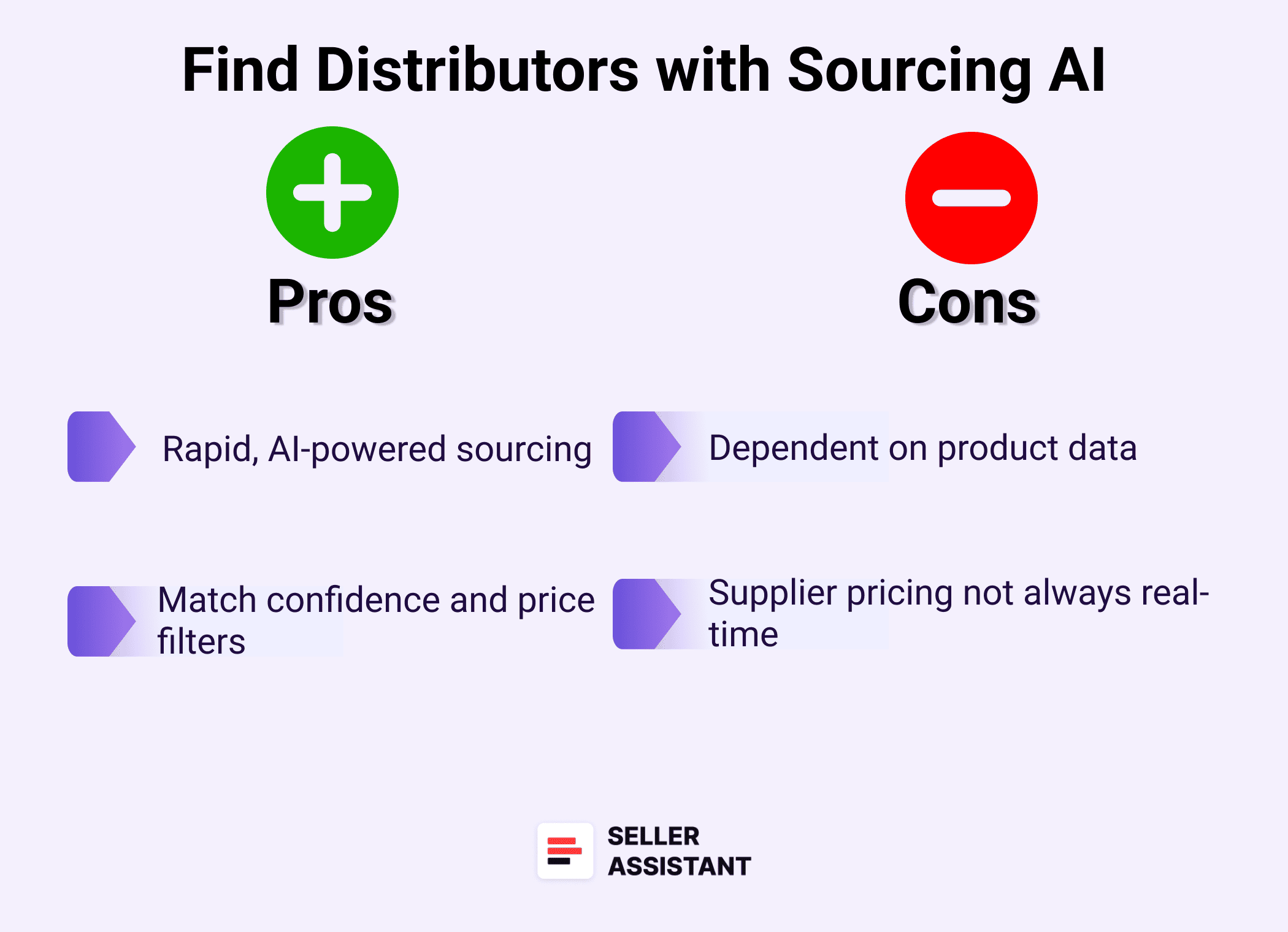
Недостатки, которые следует учитывать
- Зависимость от данных о продукте
Если в листингах отсутствуют UPC или номера моделей, достоверность совпадения может снизиться – что потребует ручной проверки.
- Цены могут быть не в реальном времени
Sourcing AI извлекает данные с общедоступных страниц поставщиков, поэтому всегда подтверждайте цену и наличие перед размещением заказов.
Кому это подходит лучше всего
Этот метод идеален для оптовых продавцов FBA, которые хотят открывать новые аккаунты брендов через проверенных дистрибьюторов из США. Он также хорошо подходит для продавцов онлайн-арбитража и дропшипперов, которым требуется быстрый и точный поиск с ценовыми фильтрами и проверкой совпадений.
Метод 3. Используйте своих существующих поставщиков для поиска новых
При попытке покупать оптовые товары для продажи на Amazon многие продавцы упускают из виду мощный ярлык, скрывающийся на виду: их текущие поставщики. Большинство оптовых дистрибьюторов работают не с одним брендом – они сотрудничают с десятками. Используя эти существующие отношения, вы можете открывать неиспользованные линейки продуктов и даже получать рекомендации по новым поставщикам в той же экосистеме.
Что включает этот метод
Многие оптовые поставщики распространяют продукцию нескольких брендов – что делает их золотой жилой для расширения каталога. Как только вы установили отношения с поставщиком, они часто предоставляют полный прайс-лист, который включает все бренды, которые они продают. В этих списках могут быть скрыты высокопотенциальные продукты и менее известные бренды, которые вы еще не исследовали.
Эта стратегия позволяет вам увеличивать свой инвентарь без трудностей, связанных с построением новых отношений с нуля – и с дополнительным бонусом в виде работы через кого-то, кому вы уже доверяете.
Как это сделать
Шаг 1. Запросите у вашего поставщика полный список брендов или продуктов, как только вы наладите контакт.
- Ищите незнакомые бренды – сосредоточьтесь на тех, которые находятся в вашей нише или предлагают лучшую маржу.
Шаг 2. Используйте Seller Assistant's Brand Analyzer для оценки каждого бренда:
- Ассортимент продуктов
- Ежемесячный доход
- Конкуренция продавцов
- Ограничения на перепродажу (используйте Bulk Restriction Checker от Seller Assistant).
- Шаг 3. Приоритизируйте бренды, которые соответствуют вашим критериям прибыли и конкуренции, и свяжитесь с вашим поставщиком для получения информации о MOQ и ценах.
Умное дополнение: используйте рекомендации поставщиков
Не останавливайтесь на списке брендов. Спросите своего поставщика, работает ли он с другими дистрибьюторами, с которыми он сотрудничает, или может ли он направить вас к ним. Поставщики часто имеют обширные сети, и теплое знакомство может значительно облегчить вашу следующую беседу о поиске поставщика.
Преимущества этого метода
- Расширение с минимальными усилиями
Поскольку у вас уже есть одобренный аккаунт, поставщик может помочь вам открыть новые бренды без дополнительных препятствий.
- Углубляет отношения с поставщиками
Это превращает разовые сделки в многобрендовые партнерства и органично расширяет вашу сеть поставщиков.

Недостатки, которые следует учитывать
- Требуется ручной анализ
Даже при наличии прайс-листа все равно требуется время, чтобы проверить, какие бренды прибыльны и подходят для перепродажи.
Совет. Чтобы автоматизировать отделение выгодных сделок от неликвидного товара, используйте такие инструменты, как Seller Assistant's Brand Analyzer и Price List Analyzer. .
- Brand Analyzer помогает вам оценивать прибыльность и конкурентоспособность бренда на уровне бренда, используя реальные данные Amazon.
- Price List Analyzer сопоставляет UPC/EAN поставщика с ASIN и заполняет вашу электронную таблицу важными метриками, такими как прибыль, ROI, скорость продаж и ограничения – позволяя мгновенно фильтровать выгодные сделки и создавать список покупок, основанный на данных.
- Не каждый бренд жизнеспособен
Некоторые могут иметь слабый спрос, плохие отзывы или сильное присутствие Amazon, что ограничивает маржу.
Кому это подходит лучше всего
Этот подход идеально подходит для продавцов, у которых уже есть одно или несколько оптовых отношений с поставщиками и которые хотят углубить их, одновременно находя новые продукты для перепродажи на Amazon. Он особенно хорошо работает для продавцов, ориентированных на нишу, ищущих способы добавить смежные бренды без слепого поиска с нуля.
Метод 4. Покупайте у местных и региональных брендов
Если вы хотите покупать оптовые товары для продажи на Amazon, которые выделяются и сталкиваются с меньшей конкуренцией, местные и региональные бренды являются разумным решением. Небольшие производители, семейные предприятия и нишевые производители часто не полностью представлены на Amazon – или вообще не продают там.
Это дает вам уникальное преимущество: возможность быть первым на рынке с эксклюзивными листингами, одновременно выстраивая прямые, партнерские отношения с владельцами брендов.
Что включает этот метод
Местные бренды – особенно те, что относятся к специализированным или кустарным категориям – часто производят высококачественные продукты, но не имеют достаточного опыта или инфраструктуры для продажи на Amazon самостоятельно. Как оптовый продавец, вы можете выступить в качестве связующего звена: размещая эти продукты в Интернете, управляя листингами и помогая бренду расширить свой охват через ваш магазин.
Поскольку эти предприятия меньше, они обычно более открыты для партнерства, индивидуальных условий и гибких договоренностей – особенно если вы уже работаете с брендами в той же нише или регионе.
Как это сделать
Шаг 1. Ищите местные и региональные бренды в вашей категории товаров с помощью:
- Местные бизнес-справочники
- Торговые ассоциации
- Сама Amazon (чтобы найти листинги с низкой конкуренцией)
Шаг 2. Приоритизируйте малые или семейные предприятия, которые недостаточно представлены или отсутствуют на Amazon.
Шаг 3. Обратитесь с персонализированным сообщением или телефонным звонком:
- Представьте свой бизнес
- Поделитесь своим интересом к перепродаже их продукции
- Объясните, как Amazon может стать для них новым источником дохода
Шаг 4. Договоритесь о ценах, доставке и условиях MOQ на основе вашего типичного объема и стратегии категории.
Дополнительный совет: используйте местные связи
Если вы находитесь в регионе, богатом производителями кустарных или нишевых продуктов, посещение общественных деловых мероприятий, местных выставок или фермерских рынков может открыть новые возможности для поиска поставщиков. Личная беседа часто позволяет заключить сделки, которые невозможно получить по электронной почте.
Преимущества этого метода
- Низкая конкуренция, высокая уникальность
Вы можете выставлять на продажу продукты, которые не переполнены сторонними продавцами, увеличивая свои шансы выиграть Buy Box и устанавливать свои собственные цены.
- Более гибкие переговоры
Малые бренды часто готовы сотрудничать по ценам, условиям и даже возможностям совместного брендинга.
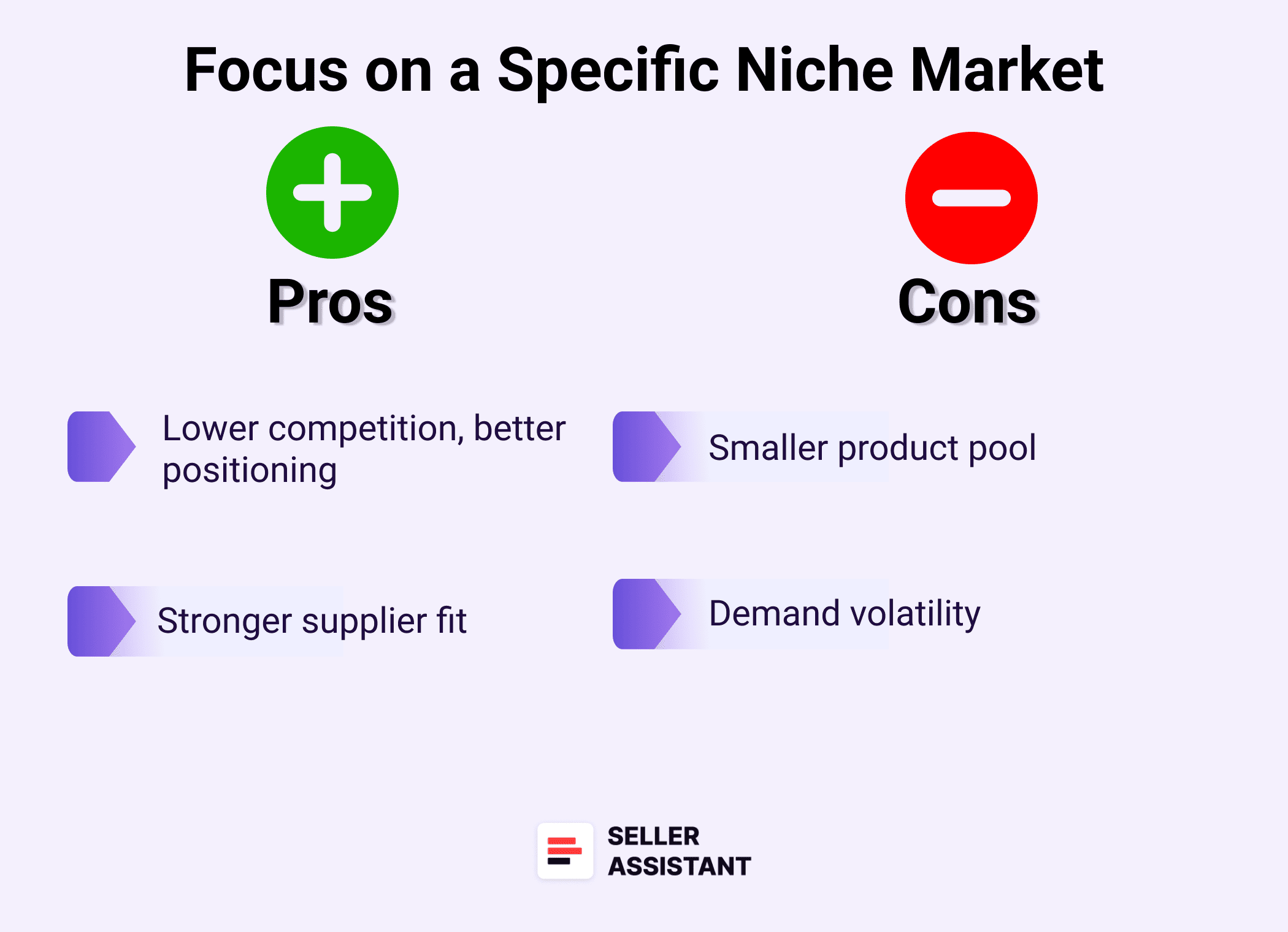
Недостатки, которые следует учитывать
- Ограниченная масштабируемость
Местные бренды могут не иметь объема производства или систем выполнения заказов, необходимых для быстро оборачиваемого инвентаря.
- Операционные пробелы
Небольшие предприятия часто не имеют оптовой инфраструктуры – что означает более медленное выставление счетов, задержки в выполнении заказов или трудности в общении.
Кому это подходит лучше всего
Идеально подходит для продавцов Amazon, которые хотят создать тщательно подобранный каталог продуктов с низкой конкуренцией, которые трудно найти. Этот подход особенно хорошо работает в региональных категориях, товарах ручной работы, специализированных продуктах питания, товарах для дома, товарах для здоровья и личной гигиены – где брендинг, аутентичность и уникальность стимулируют продажи.
Метод 5. Используйте свои существующие связи
Один из наиболее упускаемых из виду способов покупки оптовых товаров для продажи на Amazon – это использование уже имеющихся у вас профессиональных и личных связей. Многие продавцы Amazon так сильно сосредоточены на инструментах и холодном охвате, что забывают: реальные связи могут открыть надежные, высокодоходные возможности поиска поставщиков быстрее, чем любая база данных.
Ваша сеть – бывшие работодатели, коллеги по отрасли, прошлые поставщики, владельцы местного бизнеса, даже друзья и семья – уже могут быть связаны с брендами, производителями или оптовиками, которые открыты для новых каналов продаж. Эти отношения могут обеспечить более теплое знакомство, более быстрое построение доверия и более гибкие условия сделки, чем начало с нуля.
Даже если кто-то из вашей сети сам не занимается оптовой торговлей, он может порекомендовать вам кого-то, кто занимается – особенно в тесно связанных отраслях или регионах.
Как это сделать
Шаг 1. Составьте список всех, кто в вашей профессиональной или местной сети может иметь доступ к поставщикам:
- Бывшие коллеги в розничной торговле или дистрибуции
- Деловые контакты в электронной коммерции, логистике или операциях
- Личные друзья или члены семьи, работающие с физическими продуктами
Шаг 2. Обратитесь напрямую и спросите:
- Знают ли они какие-либо бренды, поставщиков или производителей, которые ищут расширения?
- Готовы ли они связать вас с потенциальными оптовыми партнерами?
- Можете ли вы быть рекомендованы кому-то, кто может испытывать трудности с получением онлайн-видимости?
Шаг 3. Когда вы получите потенциального клиента, относитесь к этому как к предложению, ориентированному на отношения:
- Сохраняйте разговор неформальным, но профессиональным
- Подчеркните, какую ценность вы принесете бренду
- Поделитесь своим опытом продавца Amazon и историями успеха
Дополнительный совет: восстановите связь с прошлыми поставщиками
Если вы когда-либо покупали товары оптом для другого бизнеса или побочного проекта, вернитесь к этим поставщикам. Возможно, они расширили свои предложения или теперь представляют несколько брендов, которые подходят для FBA.
Преимущества этого метода
- Теплые знакомства вызывают доверие
Лиды через знакомых вам людей с большей вероятностью приведут к конверсии и долгосрочным партнерствам.
- Меньше препятствий
Эти связи часто обходят бюрократию официальных заявок, брендинговых ограничений и длительных циклов одобрения.
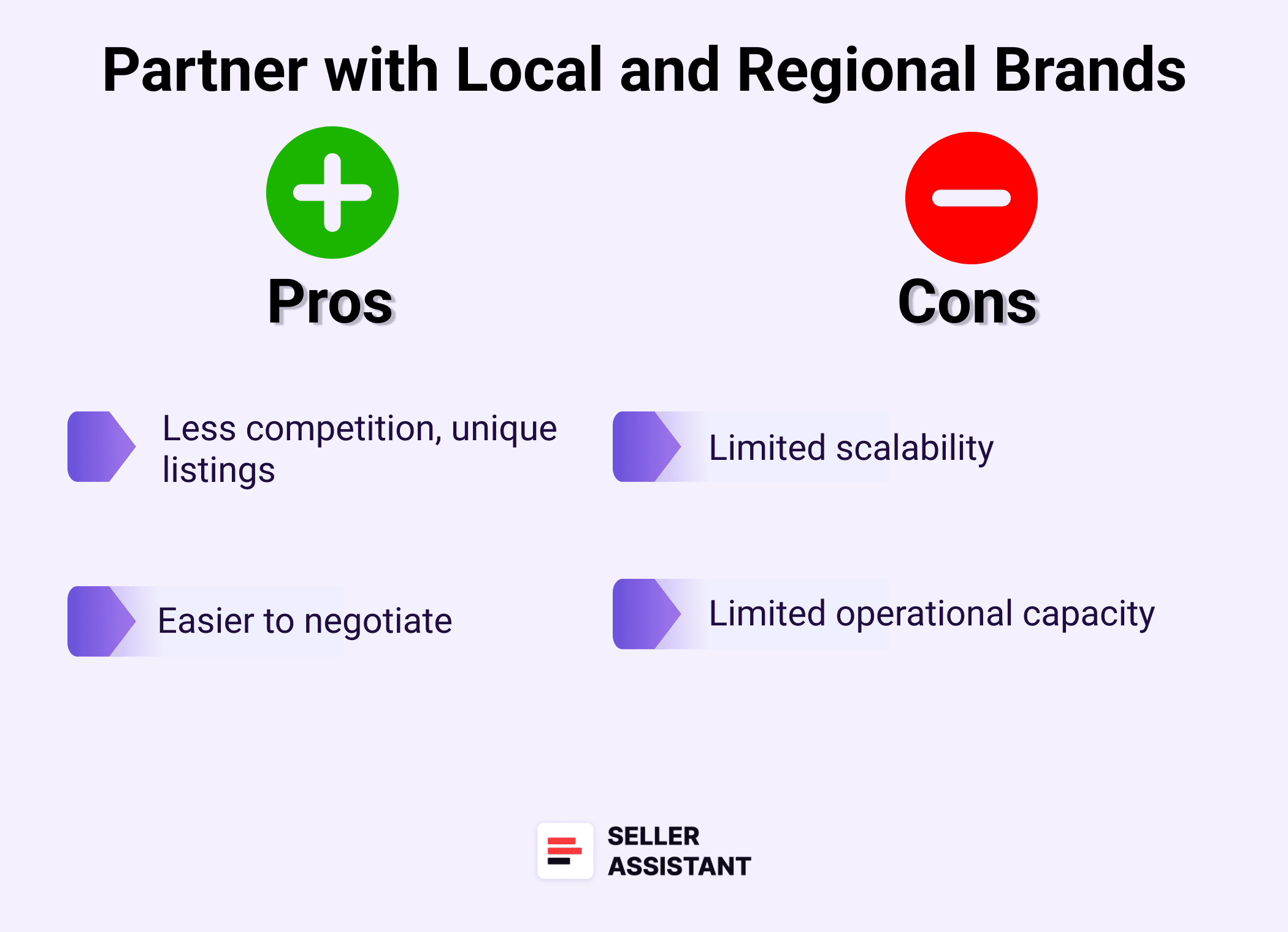
Недостатки, которые следует учитывать
- Ограниченный объем лидов
Ваша личная сеть может дать лишь несколько возможностей – хотя и очень качественных.
- Неформальные соглашения
Сделки, инициированные через связи, могут быть неструктурированными, поэтому всегда подтверждайте условия в письменной форме, чтобы избежать недопонимания.
Кому это подходит лучше всего
Этот подход хорошо подходит для начинающих продавцов с сильным опытом работы в офлайн-бизнесе или опытных продавцов Amazon, которые хотят покупать оптовые товары для продажи на Amazon через основанный на отношениях, высокодоверительный поиск. Он особенно ценен для продавцов, желающих добавить бутиковые, нишевые или регионально sourced продукты в свой каталог, не полагаясь на холодные лиды.
Метод 6. Используйте каталоги оптовых поставщиков
Если вы хотите покупать оптовые товары для продажи на Amazon, не тратя дни на поиски потенциальных клиентов, каталоги оптовых поставщиков — это надежное место для начала. Эти платформы представляют собой тщательно подобранные базы данных производителей, дистрибьюторов и поставщиков Amazon FBA – организованные по категориям товаров, регионам и т. д.
Они особенно полезны для начинающих или для опытных продавцов, выходящих на новую нишу, предлагая заранее проверенные варианты поставщиков с минимальными затратами на исследование.
Что включает этот метод
Оптовые каталоги собирают большие списки поставщиков по нескольким категориям – от потребительских товаров и моды до промышленной продукции. Вместо того чтобы охотиться за отдельными дистрибьюторами, вы получаете мгновенный доступ к тысячам потенциальных партнеров через единый портал.
Вы можете фильтровать поставщиков по:
- Категория продукта
- Местоположение
- Минимальный объем заказа (MOQ)
- Политика доставки
Как только вы нашли несколько потенциальных партнеров, свяжитесь с ними, чтобы запросить их каталоги продукции, проверить условия для реселлеров и начать строить отношения.
Лучшие каталоги оптовых поставщиков для продавцов Amazon
Платный каталог с более чем 8000 проверенными поставщиками. Отлично подходит для фирменных и нишевых потребительских товаров.
Каталог с пожизненным доступом, содержащий более 16 миллионов продуктов и сертифицированных оптовиков.
Бесплатный каталог на территории США. Менее курируемый, но отлично подходит для быстрого поиска и просмотра оптовых поставщиков.
Известен своей автоматизацией дропшиппинга; также предлагает каталог поставщиков с готовыми к интеграции поставщиками.
Промышленный каталог поставщиков. Идеально подходит для продуктов B2B и специализированного производства в США.
Оптовый рынок для ремесленных и независимых брендов – силен в товарах для дома и бутиковых товарах.
Платформа без комиссии, предлагающая прямой доступ к поставщикам товаров для дома и подарков из США.
Общий каталог B2B с листингами по десяткам категорий.
Европейский каталог фирменной одежды, обуви и аксессуаров.
Нишевый каталог поставщиков в США для товаров для дома и образа жизни – отлично подходит для продавцов с тщательно подобранными каталогами.
Преимущества этого метода
- Быстрый поиск поставщиков
- Вы получаете немедленный доступ к сотням или тысячам оптовых поставщиков – никаких холодных звонков или трудоемких исследований не требуется.
- Подходит для начинающих
- Каталоги предлагают низкий порог входа с заранее проверенными поставщиками, что делает их идеальными, если вы новичок в оптовом поиске.
Недостатки, которые следует учитывать
- Смешанное качество поставщиков
- Хотя многие каталоги проверяют поставщиков, некоторые все еще могут иметь ограниченный ассортимент, слабое выполнение заказов или ограничения политики Amazon. Всегда проверяйте перед размещением заказов.
- Отсутствие эксклюзивности
- Поскольку другие продавцы используют те же каталоги, уникальный доступ к продуктам и прямые отношения с брендами труднее достичь только этим методом.
Кому это подходит лучше всего
Наиболее подходит для новых и средних продавцов Amazon, которые хотят покупать оптовые товары для продажи на Amazon без глубоких ручных исследований. Также идеально подходит для продавцов, выходящих на новые категории или желающих эффективно расширить свою базу поставщиков.
Метод 7. Посещайте выставки и отраслевые мероприятия
Если вы хотите покупать оптовые товары для продажи на Amazon и хотите наладить серьезные, долгосрочные связи с поставщиками, посещение торговых выставок — одно из самых мощных действий, которые вы можете предпринять. Эти личные мероприятия дают вам доступ к сотням производителей, дистрибьюторов и представителей брендов – все в одном месте.
Выставки идеально подходят для построения доверительных отношений, тщательной оценки продуктов и заключения сделок быстрее, чем это когда-либо могли сделать электронная почта или холодный обзвон.
Что включает этот метод
Торговые выставки и B2B-экспозиции полны потенциала для поиска поставщиков – особенно если вы ориентируетесь на мероприятия, специфичные для вашей категории товаров. Независимо от того, продаете ли вы игрушки, товары для здоровья, товары для дома или специализированные продукты питания, вероятно, найдется выставка, которая соответствует вашей нише.
Платформы, такие как 10times.com, TSNN и ExpoGuide, позволяют вам находить предстоящие события по местоположению, категории и направлению.
При посещении:
- Возьмите визитные карточки
- Подготовьте документацию для реселлеров
- Будьте готовы представить свой магазин Amazon как канал сбыта
- Собирайте каталоги, спрашивайте об условиях оптовых продаж и договаривайтесь о ценах в режиме реального времени
Лучшие торговые выставки в США для оптового поиска поставщиков на Amazon
- ASD Market Week (Лас-Вегас, Невада)
Одна из крупнейших B2B торговых выставок в США, включающая товары общего назначения, моду, электронику и многое другое.
- Toy Fair® (Нью-Йорк, Нью-Йорк)
Главное событие для индустрии игрушек, игр и молодежных развлечений – отлично подходит для планирования 4 квартала и поиска брендов.
- Natural Products Expo West (Анахайм, Калифорния)
Главная выставка органических продуктов питания, товаров для здоровья, добавок и экологически чистых косметических средств.
- NY NOW (Нью-Йорк, Нью-Йорк)
Ориентирован на товары для дома, образа жизни, ремесленные изделия и сезонные подарки – отлично подходит для тщательно подобранных каталогов.
- Fancy Food Show (Нью-Йорк, Нью-Йорк и Лас-Вегас, Невада)
Крупнейшее североамериканское мероприятие по специализированным продуктам питания – наполнено изысканными, этническими и популярными продуктами.
- White Label World Expo Expo (Лас-Вегас, Невада)
Предназначен для продавцов Amazon и электронной коммерции – встречайтесь с производителями и поставщиками услуг для разработки частных торговых марок.
- Global Pet Expo (Орландо, Флорида)
Идеально подходит для продавцов в нише зоотоваров – охватывает все от кормов и аксессуаров до товаров для груминга.
- The Inspired Home Show (Чикаго, Иллинойс)
Крупнейшее событие в США для кухонной утвари, чистящих средств, хранения и предметов первой необходимости для дома.
- Licensing Expo (Лас-Вегас, Невада)
Для продавцов, заинтересованных в официально лицензированных продуктах, мерчендайзинге персонажей и партнерстве с брендами.
- MAGIC Las Vegas / SOURCING at MAGIC (Лас-Вегас, Невада)
Главное событие по поиску модной одежды и аксессуаров – отлично подходит для продавцов одежды и исследования частных торговых марок.
Преимущества этого метода
- Встреча с поставщиками лицом к лицу
Установите доверие, задавайте реальные вопросы и производите сильное впечатление – все это поможет вам получить одобрение и заключать более выгодные сделки.
- Найдите неизведанные бренды
Многие малые и развивающиеся компании участвуют в торговых выставках в поисках реселлеров, что делает эти мероприятия идеальными для выявления уникальных продуктовых линеек до того, как это сделают конкуренты.
Недостатки, которые следует учитывать
- Расходы на поездку и посещение
Авиабилеты, проживание в отелях и входные билеты могут быстро накапливаться – особенно для начинающих или индивидуальных продавцов.
- Потерянный потенциал без подготовки
Если вы не придете с четким предложением и планом дальнейших действий, легко потерять импульс после мероприятия.
Кому это подходит лучше всего
Лучше всего подходит для продавцов, которые хотят масштабироваться, строя эксклюзивные отношения с брендами или открывая оптовые товары, не найденные на основных платформах. Также идеально подходит для продавцов, расширяющих свои источники поставок за пределы только онлайн-методов на более доверительные, личные каналы.
Метод 8. Быстрый старт с заранее проверенными списками поставщиков
Если вы хотите покупать оптовые товары для продажи на Amazon, не тратя недели на поиск поставщиков, курируемые списки поставщиков предлагают упрощенную альтернативу. Эти списки собирают проверенных, американских оптовых поставщиков Amazon FBA в различных категориях товаров – давая вам преимущество в поиске поставщиков.
Вместо того чтобы начинать с нуля, вы сразу переходите к оценке сделок и запросу каталогов у поставщиков, которые уже совместимы с Amazon.
Что включает этот метод
Курируемые списки поставщиков идеально подходят для продавцов, которым нужен ярлык для поиска надежных оптовых партнеров. Инструменты, такие как курируемый Список из 500+ поставщиков из США от Seller Assistant, устраняют догадки. Вы просто выбираете поставщиков, которые подходят вашей нише, запрашиваете их списки продуктов и загружаете их в Price List Analyzer от Seller Assistant.
Оттуда вы можете мгновенно фильтровать по любой метрике и создать список покупок. Это позволяет вам создать короткий список прибыльных продуктов за считанные минуты – вместо ручного сканирования таблиц или листингов.
Преимущества этого метода
- Экономит время на исследование
Пропустите часы поиска в Google, проверки неизвестных каталогов или холодных рассылок поставщикам.
- Сочетается с инструментами массового анализа
В сочетании с Price List Analyzer вы можете оценивать каталоги поставщиков в масштабе – сопоставлять товары с ASIN, проверять соответствие и автоматически рассчитывать маржу.
Недостатки, которые следует учитывать
- Не полностью эксклюзивный
Другие продавцы могут использовать тот же курируемый список – поэтому конкурентные исследования на уровне продукта по-прежнему важны.
- Требует последующих действий
Вам все равно нужно связаться с каждым поставщиком, чтобы запросить цены, подтвердить MOQ и выполнить любые требования по одобрению учетной записи.
Кому это подходит лучше всего
Наиболее подходит для занятых или начинающих продавцов Amazon, которые хотят масштабироваться быстрее, используя проверенные списки поставщиков. Этот подход устраняет трудности на ранних этапах и помогает вам сосредоточиться на выборе продукта и потенциальной прибыли – а не только на поиске поставщиков.
FAQ
Лучший способ найти оптовые товары для продажи на Amazon
Лучший подход — это сочетание инструментов, основанных на данных, таких как Brand Analyzer, с проверенными методами поиска, такими как каталоги поставщиков, торговые выставки и проверенные курируемые списки. Это гарантирует, что вы выбираете продукты на основе реальных показателей производительности, а не догадок.
Нужна ли лицензия на ведение бизнеса для покупки оптом?
Да, большинство легальных оптовых поставщиков требуют сертификат реселлера или бизнес-лицензию для открытия счета и доступа к оптовым ценам. Это показывает, что вы ведете законный бизнес, а не являетесь розничным потребителем.
Как избежать поддельных или некачественных оптовых поставщиков
Придерживайтесь проверенных платформ, посещайте торговые выставки или используйте надежные инструменты, такие как курируемый список поставщиков Seller Assistant и Sourcing AI. Всегда проверяйте веб-сайты поставщиков, проверяйте прозрачность контактов и, по возможности, запрашивайте образцы.
Могут ли новые продавцы покупать напрямую у брендов?
Да, но многие бренды будут запрашивать доказательства истории продаж, бизнес-документацию или четкое ценностное предложение. Такие инструменты, как Brand Analyzer от Seller Assistant, могут помочь вам определить, какие бренды открыты для новых реселлеров.
Как проверить, прибылен ли оптовый товар
Используйте такие инструменты, как Price List Analyzer, чтобы сопоставлять UPC поставщика с ASIN и рассчитывать ROI, рентабельность, скорость продаж и все другие важные метрики сделки. Это позволяет отфильтровывать неприбыльные товары и сосредоточиться только на товарах, готовых к перепродаже.
Заключительные мысли
Поиск правильного способа покупки оптовых товаров для продажи на Amazon не обязательно должен быть сложным – особенно когда вы сочетаете умные инструменты с проверенными стратегиями поиска. Независимо от того, строите ли вы отношения с брендами, исследуете местных поставщиков или используете тщательно отобранные каталоги и ИИ, каждый метод имеет свои преимущества в зависимости от ваших целей и уровня опыта.
Чтобы сделать поиск товаров быстрее и прибыльнее, такие инструменты, как Seller Assistant, предлагают встроенные функции, такие как Brand Analyzer, Price List Analyzer, Sourcing AI и тщательно отобранные списки поставщиков – помогая вам с уверенностью переходить от исследования к принятию решений о покупке.
Seller Assistant — это универсальное программное обеспечение для поиска товаров, предлагающее все функции, жизненно важные для поиска товаров. Оно объединяет три расширения: Seller Assistant Extension, IP Alert, и VPN by Seller Assistant, инструменты: Price List Analyzer, Seller Spy, Bulk Restrictions Checker, и API integrations, и функции: Side Panel View, FBM&FBA Profit Calculator, Quick View, ASIN Grabber, UPC/EAN to ASIN converter, Stock Checker, и другие функции, которые помогают быстро находить высокодоходные сделки. Seller Assistant также предлагает интеграцию с Zapier, позволяющую создавать настраиваемые рабочие процессы по поиску товаров.
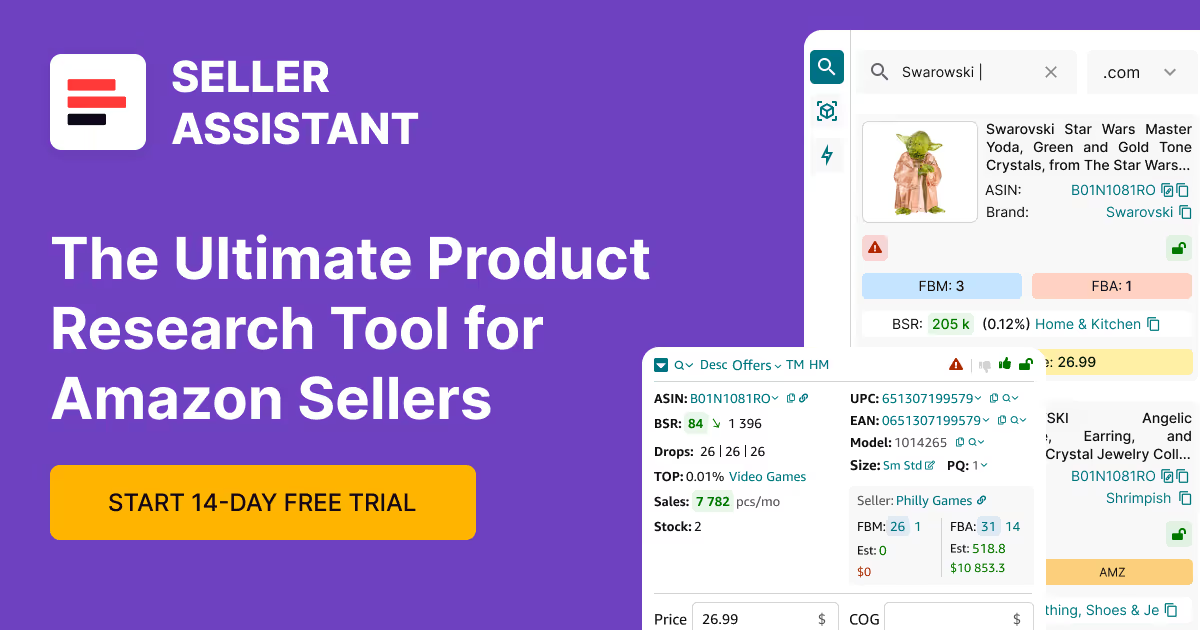
.svg)














